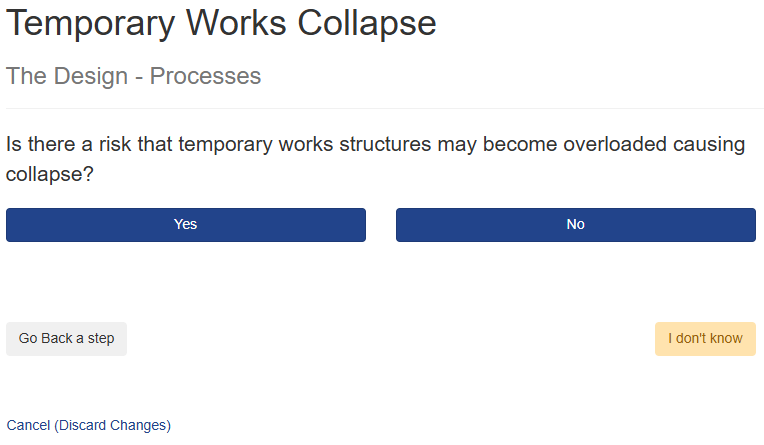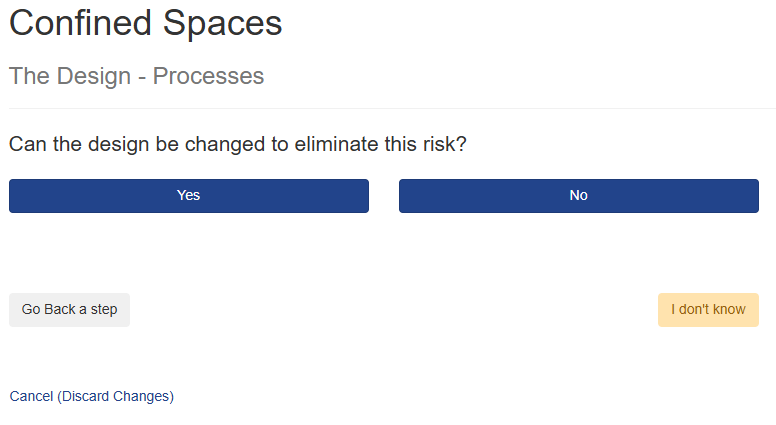The HARI was designed to provide a thorough, but not exhaustive, list of potential Risks to be considered during the Design phase of a Project. Only users with Design Responsibility will be required to complete the HARI, for these users the HARI will be visible, but they can only see what other users have answered, and will not be able to provide input themselves. The PD can provide notes or comments on each HARI, but if they do not have contractual Design Responsibility according to CDM2015 then they will not be required to answer.
The HARI - the Hazard Assessment and Risk Identification tool within Mosaic is a wizard-based Q&A which walks the Designer through the Risks and asks questions pertinent to that Risk, in the hope of either Eliminating that Risk through Design Changes, or Mitigating the Risk via the provision of more information for other Project team members.
The first question in every HARI is "Is there a Risk of..." which can be answered No, to Eliminate that Risk completely from the Risk Register at the outset. Below is a typical HARI, every HARI is unique, accordingly there are different questions and pathways through each, so the below is just an illustration and you should not expect every HARI to look like the example below.
Every HARI can be done unlimited times by each user with Design Responsibility, so if a team member becomes convinced during a Design Meeting that their answers could be altered, should re-do the HARI for that Element, and re-submit the Risk Register to the Team once complete. The Risk Register is a live document which contains the latest responses from all users. It always shows the up-to-date status of the Risks in the HARI, within a minute or so of the HARI being completed. If the HARI does not show your latest response, try to download it again in a minute or two, to give the system time to update it.
Answering HARI Questions, a walkthrough:
Ideally, there would be no Risks on a Project, but this is not the case in the real world. There will be occasions where a Risk is not present on a project, in which case, the task in HARI is to answer the initial question with NO.
First Question, Is there a Risk?

This will eliminate this Risk, and demonstrate that you have considered, but ruled out this Risk, by marking it Green.

Next Question, Is it Relevant to your Design Role?
The next question asks, is it Relevant to your Design Role, in other words, are you the best person to answer, or is there someone else who can better answer this, if you answer Yes, you continue through the wizard, if you answer No, it ends there and the HARI element is marked as Transferred, prompting further discussion at the next Design meeting.

If there is a Risk, Who is at Risk?
If you have answered Yes, you are asked "Who is at Risk?"
If there is a Risk, can it be "Designed out"?

If you say Yes, you will be asked to give a narrative on your proposed Design Change, if you say No, the HARI will continue to the next question, which is the last point at which this Risk can be Eliminated.
Is the Risk SIGNIFICANT?


If you answer No at this point, the Risk is Eliminated and your preceding steps are all logged, demonstrating that you have considered the Risk thoroughly but determined a competent team would foresee and deal with the Risk appropriately.
If you say Yes, then you will be asked to mark the Risk on a document which others can use to make themselves aware of the Risk. This Document will be linked in the Risk Register, and uploaded to the main Document Library for the Project, marked with a code linking it back to this HARI question, for ease of reference.

If you don't yet have this document, you can select the option "I don't have this document", which will allow you to continue, but you will need to upload it at some point. If you are using the Mosaic Task Manager, you can select to have a Task logged for you to be reminded to upload this document later.
Does this Document mitigate the Risk?
If you select "Yes", you will be asked to provide a narrative on the Reduced Risk for the Risk Register so that the contractor may refer to this information to manage the Risk better on site and the Risk will be marked as "Residual Risk, Reduced", if you select "No" you will still be asked for a Narrative to assist others, but the Risk will be marked as "Residual Risk, Not Reduced"
How HARI's appear once completed
A complete HARI will have a colour-coded status, and once completed by a member of your Company's team, it will be marked as Done for your Company. Each HARI need only be done once per team, but it must be completed by every Company with Design Responsibility, even if just to say "I have nothing to add".
Risk Eliminated:

Risk Transferred / Design Change recommended:

Residual Risk, Reduced / Manageable:

Residual Risk, not Reduced:

Risk marked "Not Relevant to me":

Risk Not Yet Reviewed:

How it appears on the Risk Register:
Every Risk has it's own row, and if identified more than once it will be on consecutive rows - it will be indicated who it was "Identified By". Any Document uploaded during the HARI will be available via a web link embedded in the PDF, you will need to be a signed in user to view that linked document. The Reference is also a clickable link which will take you to a special version of the HARI which shows how the user arrived at their conclusion, showing the path they took through the HARI.
The Status is the result of the HARI questionnaire answered by that user. The Status of the Element in the HARI will be the "worst case scenario" so if multiple users mark it as "Eliminated" but one user identifies it as a Risk, then it will show as a "Residual Risk" to promote further discussion in the Design Meeting. Anyone who becomes convinced their original response could be altered, should re-do the HARI for that element to arrive at their new conclusion.
Was this article helpful?
That’s Great!
Thank you for your feedback
Sorry! We couldn't be helpful
Thank you for your feedback
Feedback sent
We appreciate your effort and will try to fix the article